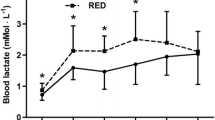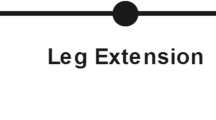Summary
This study compared glycogen depletion in active skeletal muscle after light and moderate exercise in both cold and comfortable ambient conditions. Twelve male subjects (Ss) were divided into two groups equally matched for the submaximal exercise intensity corresponding to a blood lactate concentration of 4 mM (W4) during cycle exercise. On two separate days Ss rested for 30 min at ambient temperatures of either 9‡ C or 21‡ C, with the order of temperature exposure being counter-balanced among Ss. Following rest a tissue specimen was obtained from the m. vastus lateralis with the needle biopsy technique. Six Ss then exercised on a cycle ergometer for 30 min at 30% W4 (range=50–65 W) while the remaining group exercised at 60% W4 (range=85–120 W). Another biopsy was taken immediately after exercise and both samples were assayed for glycogen content. Identical procedures were repeated for the second environmental exposure. No significant glycogen depletion was observed in the Ss exercising at 30% W4 in 21‡ C, but a 23% decrease (p=0.04) was observed when the same exercise was performed at 9‡ C. A 22% decrease (p=0.002) in glycogen occurred in the 60% W4 group at 21‡ C, which was not significantly different from that observed during the same exercise at 9‡ C. The results suggest that muscle substrate utilization is increased during light exercise in a cold environment as compared to similar exercise at a comfortable temperature, probably due to shivering thermogenesis. Heat produced with higher exercise intensities seems to be sufficient to prevent shivering and the accompanying glycogenolysis.
Similar content being viewed by others
References
Bergström J (1962) Muscle electrolytes in man. Scand J Clin Lab Invest [Suppl 68]
Bergström J, Hermansen L, Hultman E, Saltin B (1967) Diet, muscle glycogen and physical performance. Acta Physiol Scand 71:140–150
Bondar RJL, Mead D (1974) Evaluation of glucose-6-phosphate dehydrogenase from leuconastoc mesenteroides in the hexokinase method for determining glucose in serum. Clin Chem 20:586
Borg G (1970) Perceived exertion as an indicator of somatic stress. Scand J Rehab Med 2:92–98
Burton AC, Edholm OG (1955) Man in a cold environment. E. Arnold Ltd, London
Brozek J, Grand F, Anderson J, Keys A (1963) Densiometric analysis of body composition: revision of some quantitative assumptions. Ann NY Acad Sci [USA] 110:113–140
Dixon WJ, Brown MB (1979) Biomedical Computer Programs. University of California Press, Los Angeles
Fink WJ, Costill DL, Van Handel PJ (1975) Leg muscle metabolism during exercise in the heat and cold. Eur J Appl Physiol 34:183–190
Guth L, Samaha FJ (1970) Procedure for the histochemical demonstration of actomyosin ATPase. Exp Neurol 28:365–367
Hong S, Nadel E (1979) Thermogenic control during exercise in a cold environment. J Appl Physiol: Respirat Environ Exercise Physiol 47: 1084–1089
Horvath SM (1982) Exercise in a cold environment. In: Miller DI (ed) Exercise and sport sciences reviews, vol 9. Franklin Institute Press, Philadelphia, pp. 221–263
Jacobs I (1981) Lactate, muscle glycogen and exercise performance in man. Acta Physiol Scand [Suppl 495]
Karlsson J (1971) Lactate and phosphagen concentrations in working muscle of man. Acta Physiol Scand [Suppl 358]
LeBlanc J, Labrie A (1981) Glycogen and non-specific adaptation to cold. J Appl Physiol: Respirat Environ Exercise Physiol 51:1428–1432
Maughan R (1982) A simple, rapid method for the determination of glucose, lactate, pyruvate, alanine, 3-hydroxybutyrate, and aceto-acetate on a single 20-Μl blood sample. Clin Chim Acta 122:231–240
Nadel ER, Holmer I, Bergh U, Astrand P-O, Stolwijk JA (1973) Thermoregulatory shivering during exercise. Life Sci 13:983–989
Pozos R (1981) Frequency analysis of shiver in humans and its alteration by the temperature of inspired air. In: Kuehn LA (ed) Thermal constraints in diving. Undersea Medical Society Inc, pp 55–80
Pugh LGCE (1967) Cold stress and muscular exercise, with special reference to accidental hypothermia. Br Med J 2:333–337
Sherman WM, Costill DL, Fink WJ, Miller JM (1981) Effect of exercise-diet manipulation on muscle glycogen and its subsequent utilization during performance. Int J Sports Med 2:114–118
Shimada SG, Stitt JT (1983) Inhibition of shivering during restraint hypothermia. Can J Physiol Pharmacol 61:977–982
Sigma Chemical Company (1977) Technical Bulletin No 826-UV. Sigma, Saint Louis
Smith SW (1975) A new salting-out technique for colorimetric free fatty acid assays. Anal Biochem 67:531–539
Sobolova V (1969) The effect of work load in the cold upon the glycogen content in muscle and liver tissue. Physiol Bohemoslov 18:31–317
StrØmme S, Andersen KL, Elsner RW (1963) Metabolic and thermal responses to muscular exertion in the cold. J Appl Physiol 18:756–763
Author information
Authors and Affiliations
Rights and permissions
About this article
Cite this article
Jacobs, I., Romet, T.T. & Kerrigan-Brown, D. Muscle glycogen depletion during exercise at 9‡ C and 21‡ C. Europ. J. Appl. Physiol. 54, 35–39 (1985). https://doi.org/10.1007/BF00426295
Accepted:
Issue Date:
DOI: https://doi.org/10.1007/BF00426295




